The working papers and reports describe case studies where we applied the SIM-air family of tools, document general notes on various databases available for emissions and pollution modeling, and present our reviews on various topics of air pollution analysis. Some of these working papers were converted into peer reviewed journals (see publications).
 Series #57-2025: How to visualize ambient monitoring data Series #57-2025: How to visualize ambient monitoring data |
 Series #56-2025: Fuel Station Survey (FuSS) to profile in-use vehicle characteristics Series #56-2025: Fuel Station Survey (FuSS) to profile in-use vehicle characteristics |
 Series #55-2024: Value of Statistical Life (VSL) to support cost-benefit analysis of India’s air quality management Series #55-2024: Value of Statistical Life (VSL) to support cost-benefit analysis of India’s air quality management |
 Series #54-2024: Understanding Delhi’s Diwali Emission Loads Series #54-2024: Understanding Delhi’s Diwali Emission Loads |
 Series #53-2024: Overhauling India’s pollution under control (PUC) tests for multipurpose emissions information Series #53-2024: Overhauling India’s pollution under control (PUC) tests for multipurpose emissions information |
 Series #52-2024: Beginners handbook on assembling air pollution models Series #52-2024: Beginners handbook on assembling air pollution models |
 Series #51-2024: Fear of the unknown: Communicating air quality information to public and practitioners Series #51-2024: Fear of the unknown: Communicating air quality information to public and practitioners |
 Series #50-2024: Landscape review of air quality modeling in India Series #50-2024: Landscape review of air quality modeling in India |
 Series #49-2024: How to spot anomalies in data trends: Evaluating AQI data from Indian cities Series #49-2024: How to spot anomalies in data trends: Evaluating AQI data from Indian cities |
 Series #48-2024: Data from small monitoring networks is unreliable: Case of Indian cities Series #48-2024: Data from small monitoring networks is unreliable: Case of Indian cities |
 Series #47-2024: Air Quality Index Analysis for Indian Cities 2015-2023 Series #47-2024: Air Quality Index Analysis for Indian Cities 2015-2023 |
 Series #46-2021: 10 Frequently asked questions on air quality index (AQI) Series #46-2021: 10 Frequently asked questions on air quality index (AQI) |
 Series #45-2021: Aerosol speciation and meteorology data sets from Delhi supersite study – Jan’17 to Mar’18 Series #45-2021: Aerosol speciation and meteorology data sets from Delhi supersite study – Jan’17 to Mar’18 |
 Series #44-2021: 10 Frequently asked questions on Particulate Matter (PM) Series #44-2021: 10 Frequently asked questions on Particulate Matter (PM) |
 Series #43-2021: What it means to take the long view on air pollution in Delhi? Series #43-2021: What it means to take the long view on air pollution in Delhi? |
 Series #42-2021: The three kinds of people we need to fight India’s air pollution problem Series #42-2021: The three kinds of people we need to fight India’s air pollution problem |
 Series #41-2021: Raw & processed data to support energy emissions & air pollution analysis in India Series #41-2021: Raw & processed data to support energy emissions & air pollution analysis in India |
 Series #40-2021: Monitoring ambient air quality in Indian city airsheds Series #40-2021: Monitoring ambient air quality in Indian city airsheds |
 Report (2018) – Air quality analysis for Greater Bengaluru region Report (2018) – Air quality analysis for Greater Bengaluru region |
 Journal Article (2018) – Air quality analysis for Raipur-Durg-Bhillai region Journal Article (2018) – Air quality analysis for Raipur-Durg-Bhillai region |
 Report (2014) – Particulate pollution & health impacts analysis of coal-fired thermal power plants in India Report (2014) – Particulate pollution & health impacts analysis of coal-fired thermal power plants in India |
 Report (2012) – Road transport emissions in India (2010-2030) Report (2012) – Road transport emissions in India (2010-2030) |
 Report (2014) – Air quality analysis for Greater Patna region Report (2014) – Air quality analysis for Greater Patna region |
 Executive summary report (2019) – (APnA) city program for 60 Indian cities Executive summary report (2019) – (APnA) city program for 60 Indian cities |
 Report (2019) – Review of India-NCAP clean air action plans (Full report and more) Report (2019) – Review of India-NCAP clean air action plans (Full report and more) |
 Report (2019) – Accelerating city progress on clean air Report (2019) – Accelerating city progress on clean air |
 Report (2019) – The contribution of household fuels to ambient air pollution in India. More on “cooking & heating” emissions in India Report (2019) – The contribution of household fuels to ambient air pollution in India. More on “cooking & heating” emissions in India |
 Report (2019) – Comprehensive clean air action plan for the city of Patna Report (2019) – Comprehensive clean air action plan for the city of Patna |
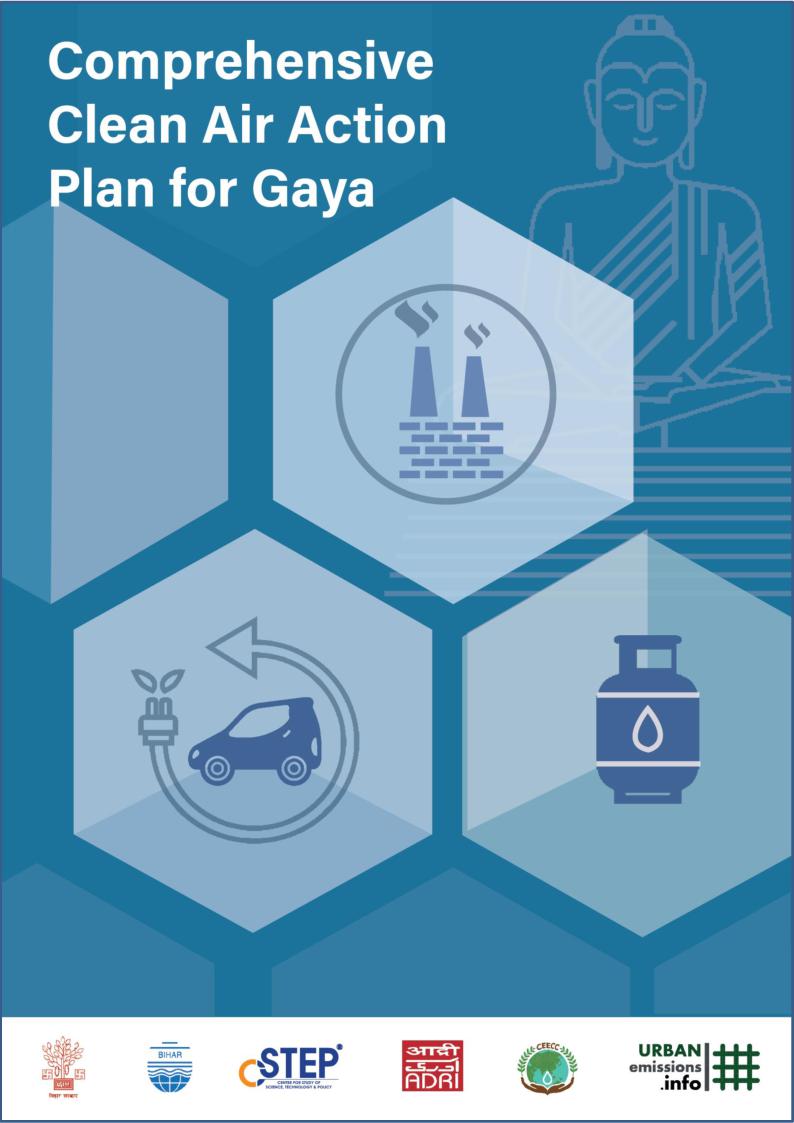 Report (2020) – Comprehensive clean air action plan for the city of Gaya Report (2020) – Comprehensive clean air action plan for the city of Gaya |
 Report (2020) – Comprehensive clean air action plan for the city of Muzaffarpur Report (2020) – Comprehensive clean air action plan for the city of Muzaffarpur |
 Series #39-2012: Urban air pollution & co-benefits analysis for Indian cities – Pune, Chennai, Indore, Ahmedabad, Surat, & Rajkot Series #39-2012: Urban air pollution & co-benefits analysis for Indian cities – Pune, Chennai, Indore, Ahmedabad, Surat, & Rajkot |
 Series #38-2012: Multi-pollutant emissions inventory for the National Capital Region of Delhi Series #38-2012: Multi-pollutant emissions inventory for the National Capital Region of Delhi |
 Series #37-2012: An analysis of health and carbon benefits using integrated air pollution modeling for Pune, India Series #37-2012: An analysis of health and carbon benefits using integrated air pollution modeling for Pune, India |
 Series #36-2011: Air quality forecasting system for cities – Modeling architecture for Delhi Series #36-2011: Air quality forecasting system for cities – Modeling architecture for Delhi |
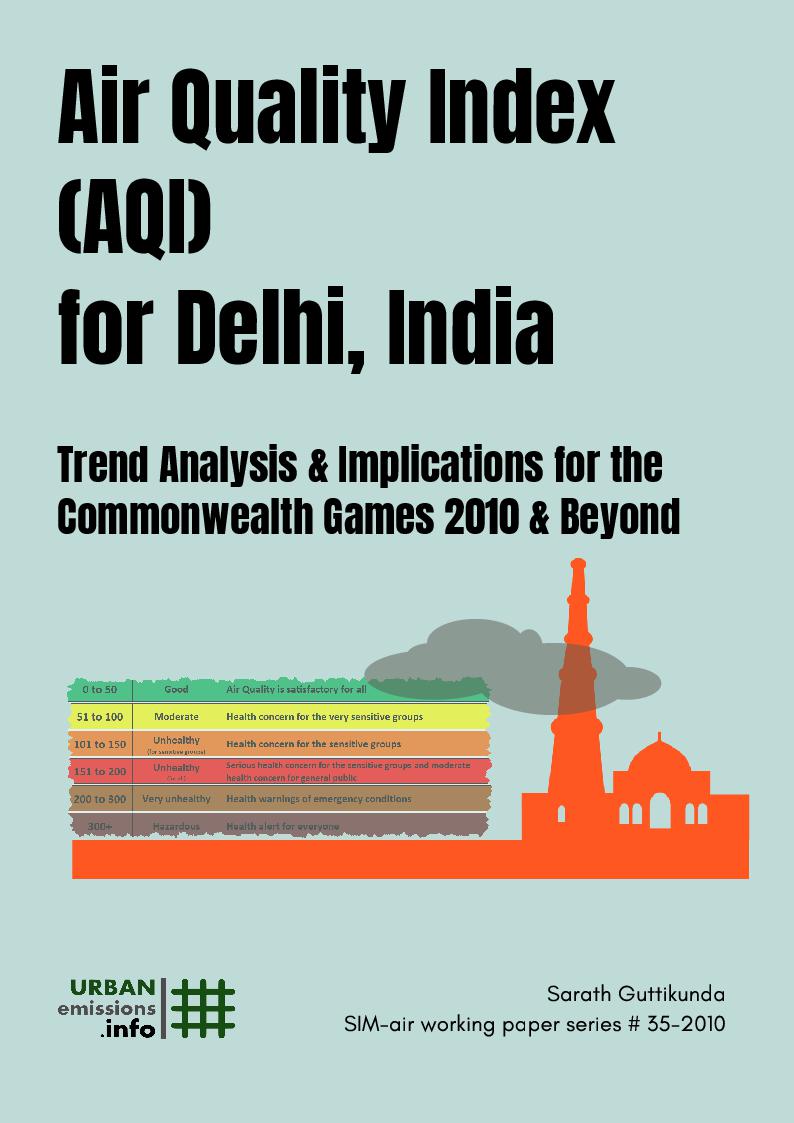 Series #35-2010: Air Quality Index (AQI) for Delhi India – Trend analysis & implications for the Commonwealth Games 2020 & beyond Series #35-2010: Air Quality Index (AQI) for Delhi India – Trend analysis & implications for the Commonwealth Games 2020 & beyond |
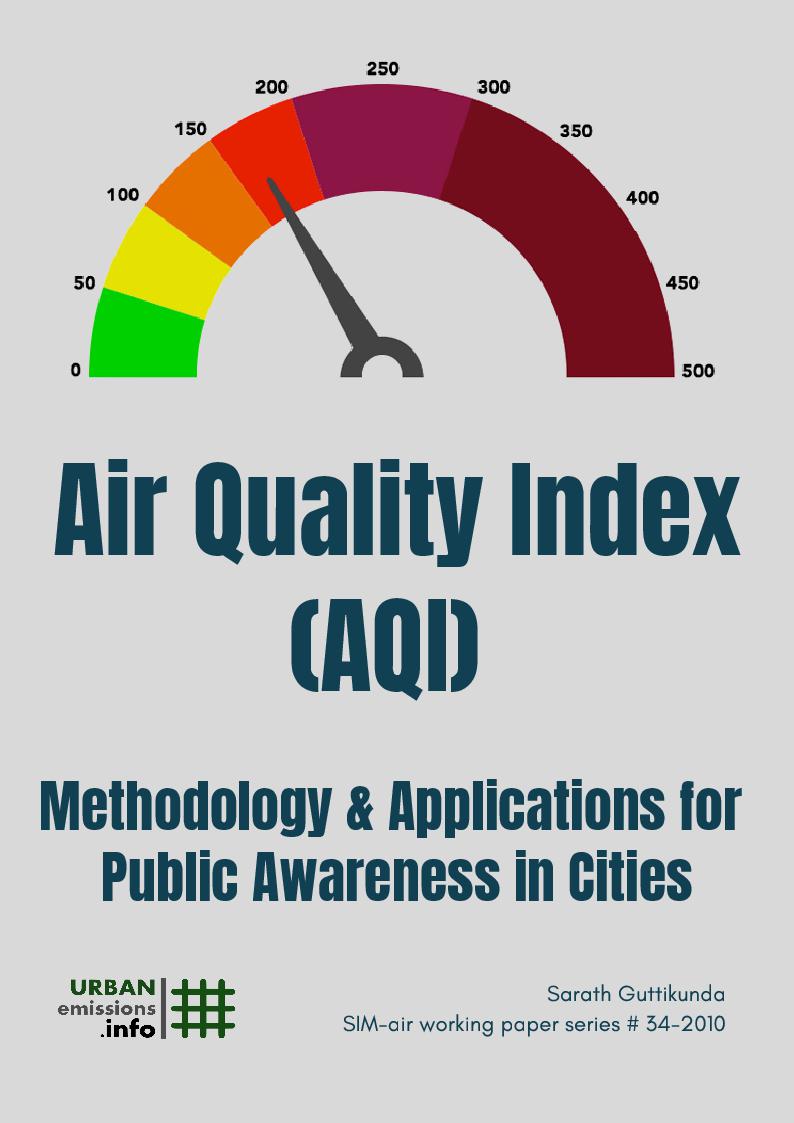 Series #34-2010: Air Quality Index (AQI) – Methodology & applications for public awareness in cities Series #34-2010: Air Quality Index (AQI) – Methodology & applications for public awareness in cities |
 Series #33-2010: Electronic road pricing – Experience & lessons from Singapore Series #33-2010: Electronic road pricing – Experience & lessons from Singapore |
 Series #32-2010: Estimated air pollution and health benefits of metro system in Delhi Series #32-2010: Estimated air pollution and health benefits of metro system in Delhi |
 Series #31-2010: Role of meteorology on urban air pollution dispersion – A 20 year analysis for Delhi, India Series #31-2010: Role of meteorology on urban air pollution dispersion – A 20 year analysis for Delhi, India |
 Series #30-2009: Simplified Atmospheric Transport Modeling System (ATMoS-4.0) for the SIM-air model Series #30-2009: Simplified Atmospheric Transport Modeling System (ATMoS-4.0) for the SIM-air model |
 Series #29-2009: Monitoring & mapping urban air pollution – A one day experiment in Delhi, India Series #29-2009: Monitoring & mapping urban air pollution – A one day experiment in Delhi, India |
 Series #28-2009: Measuring autorickshaw emissions to inform air quality policy Series #28-2009: Measuring autorickshaw emissions to inform air quality policy |
 Series #27-2009: Particulate Matter (PM) pollution in India in 2007 Series #27-2009: Particulate Matter (PM) pollution in India in 2007 |
 Series #26-2009: What is the role of air pollution modeling in policy making? Series #26-2009: What is the role of air pollution modeling in policy making? |
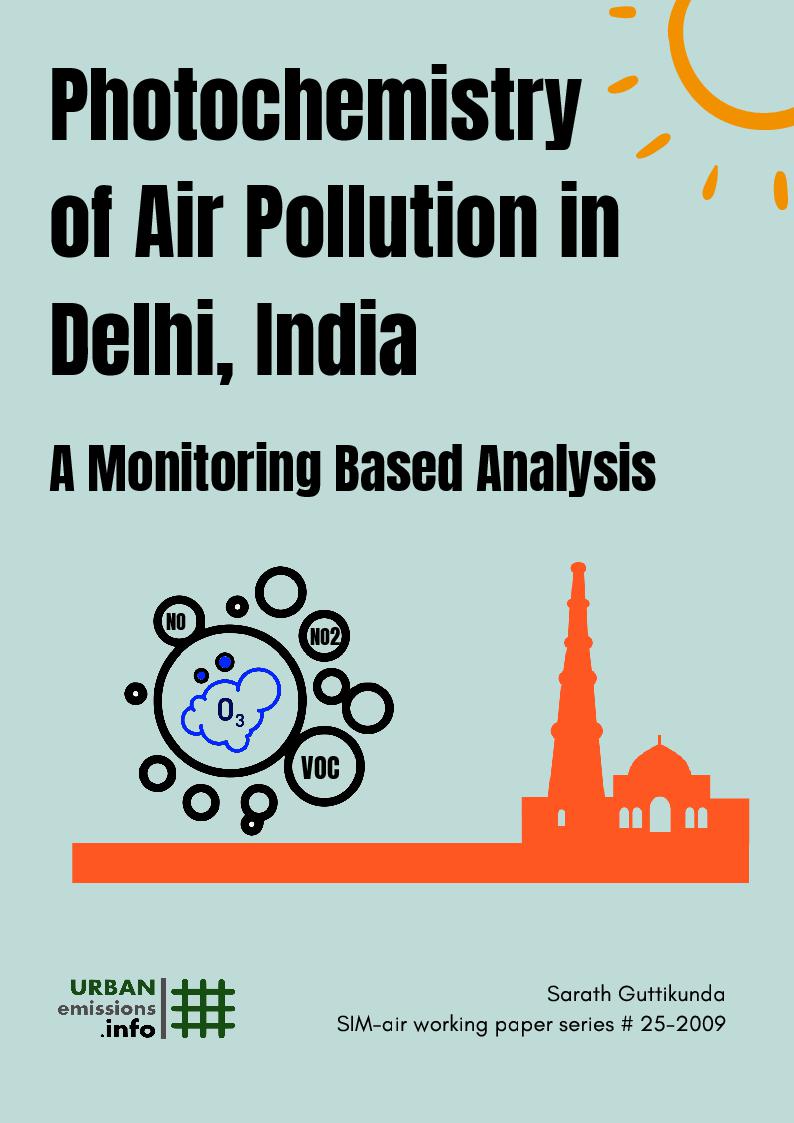 Series #25-2009: Photochemistry of air pollution in Delhi, India – A monitoring based analysis Series #25-2009: Photochemistry of air pollution in Delhi, India – A monitoring based analysis |
 Series #24-2009: Motorized passenger travel in urban India – Emissions & co-benefits analysis Series #24-2009: Motorized passenger travel in urban India – Emissions & co-benefits analysis |
 Series #23-2009: Urban particulate pollution source apportionment – Part 2: Applications, results, and policy implications Series #23-2009: Urban particulate pollution source apportionment – Part 2: Applications, results, and policy implications |
 Series #22-2009: Air quality management in Delhi, India – Then, now, and next Series #22-2009: Air quality management in Delhi, India – Then, now, and next |
 Series #21-2009: Impact analysis of brick kilns on the air quality in Dhaka, Bangladesh Series #21-2009: Impact analysis of brick kilns on the air quality in Dhaka, Bangladesh |
 Series #20-2009: Particulate pollution in Asia – Part 1: Multi-pollutant modeling of sources, contributions, & health impacts Series #20-2009: Particulate pollution in Asia – Part 1: Multi-pollutant modeling of sources, contributions, & health impacts |
 Series #19-2009: A review of air pollution from transport sector in China Series #19-2009: A review of air pollution from transport sector in China |
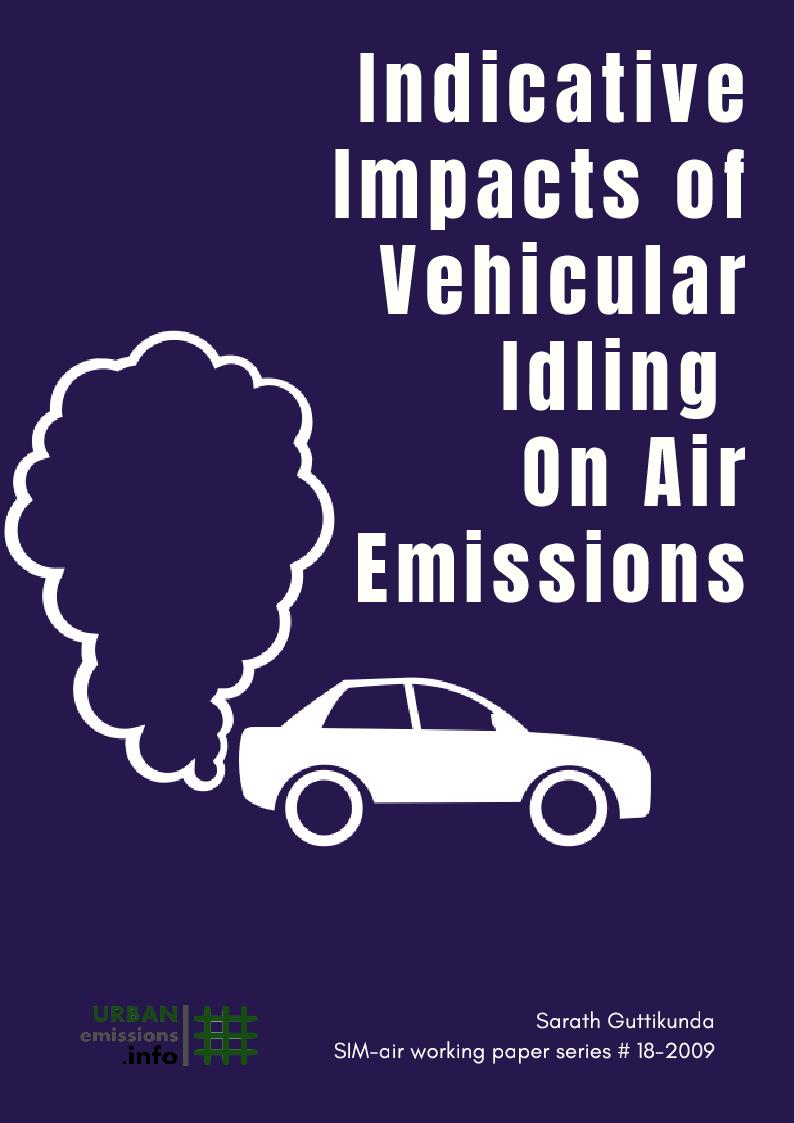 Series #18-2009: Indicative impacts of vehicular idling on air emissions Series #18-2009: Indicative impacts of vehicular idling on air emissions |
 Series #17-2009: Ten frequently asked questions about particulate matter Series #17-2009: Ten frequently asked questions about particulate matter |
 Series #16-2009: Urban particulate pollution source apportionment – Part 1: Definition, methodology, & resources Series #16-2009: Urban particulate pollution source apportionment – Part 1: Definition, methodology, & resources |
 Series #15-2009: A review of the impact of biofuels on local, regional, and global air quality Series #15-2009: A review of the impact of biofuels on local, regional, and global air quality |
 Series #14-2008: An air quality management action plan for Hanoi, Vietnam Series #14-2008: An air quality management action plan for Hanoi, Vietnam |
 Series #13-2008: Vehicular air pollution information system (VAPIS) Series #13-2008: Vehicular air pollution information system (VAPIS) |
 Series #12-2008: DIESEL program in Bangkok Series #12-2008: DIESEL program in Bangkok |
 Series #11-2008: Urban transport in India: Not so fast for the Nano car Series #11-2008: Urban transport in India: Not so fast for the Nano car |
 Series #10-2008: What is particulate matter? Composition & Science Series #10-2008: What is particulate matter? Composition & Science |
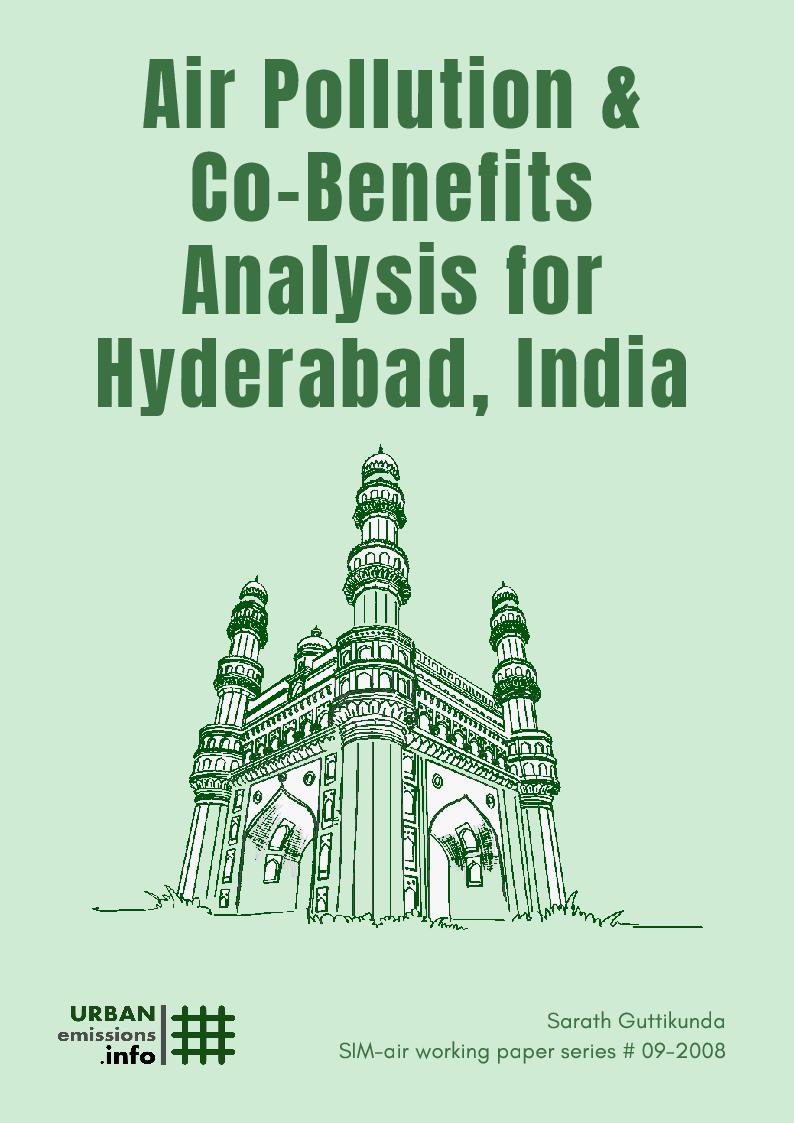 Series #09-2008: Air pollution & co-benefits analysis for Hyderabad, India Series #09-2008: Air pollution & co-benefits analysis for Hyderabad, India |
 Series #08-2008: Co-benefits: Management options for local pollution & GHG emissions control Series #08-2008: Co-benefits: Management options for local pollution & GHG emissions control |
 Series #07-2008: Estimating road dust emissions – Methods & parameters Series #07-2008: Estimating road dust emissions – Methods & parameters |
 Series #06-2008: Estimating health impacts of urban air pollution Series #06-2008: Estimating health impacts of urban air pollution |
 Series #05-2008: Urban air pollution analysis in Ulaanbaatar, Mongolia Series #05-2008: Urban air pollution analysis in Ulaanbaatar, Mongolia |
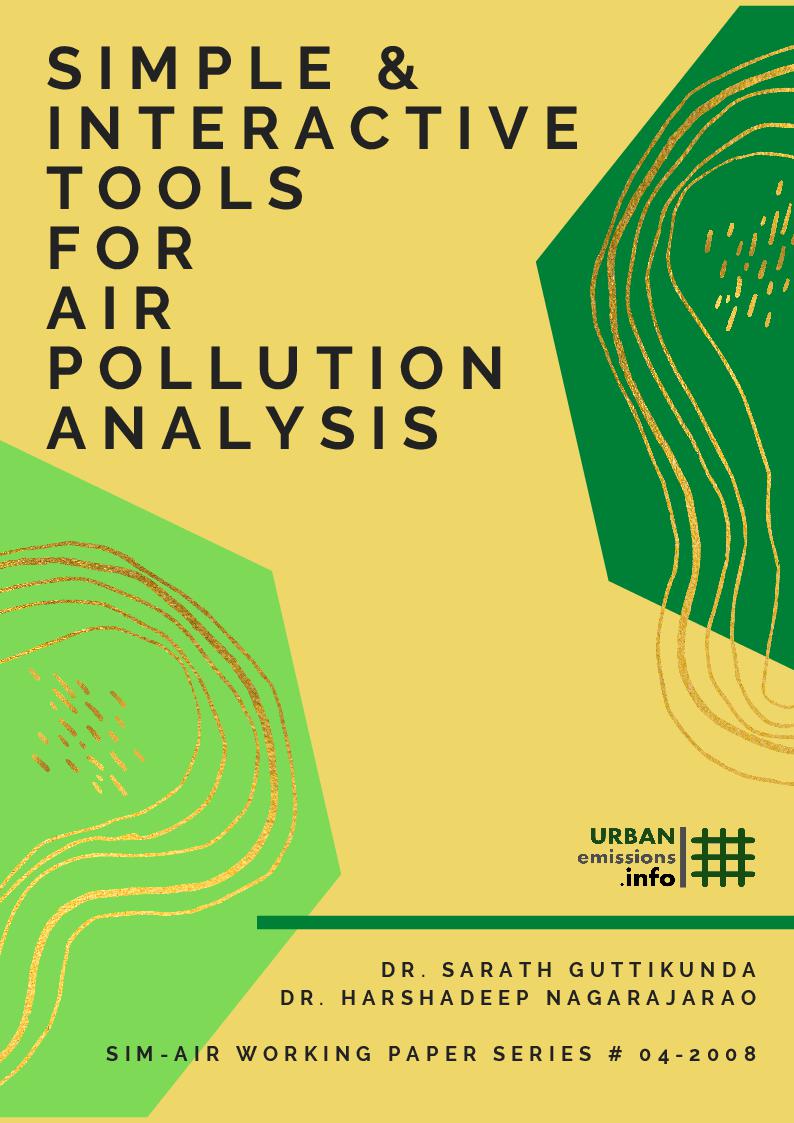 Series #04-2008: Simple & Interactive tools for air pollution analysis Series #04-2008: Simple & Interactive tools for air pollution analysis |
 Series #03-2008: Informed decision support for AQM in developing cities Series #03-2008: Informed decision support for AQM in developing cities |
 Series #02-2008: Four simple equations for vehicular emissions inventory Series #02-2008: Four simple equations for vehicular emissions inventory |
 Series #01-2008: Creating GIS road maps for urban centers Series #01-2008: Creating GIS road maps for urban centers |
